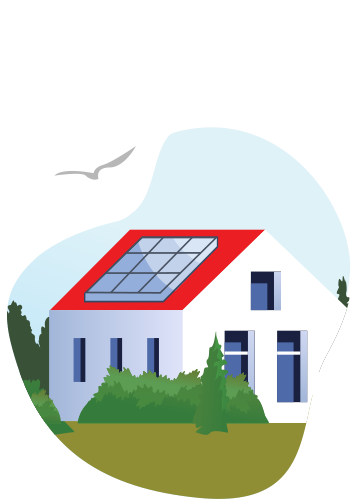- Residential grid-tied, net metered
- Off-grid
- Commercial grid-tied, net metered
- Energy storage
- Emergency back-up
Residential On-Grid
- Generate electricity for self-consumption and export any excess to the grid
- Provides energy cost savings over the long term
- Net metering available
- Typically roof-mounted; can be ground-mounted
- Potential for back-up power during grid outage (requires specific equipment)
- Canada Greener Homes grant and financing available
Solar energy in Newfoundland and Labrador, on average, has a levelized cost of energy of about 11-14 cents per kilowatt hour. When you install solar, this rate will be locked in for at least 25 years, and likely much longer, because the panels tend to impressively outlive their warranties.
Any building with a Newfoundland Power or NL Hydro metered account can install renewable energy and connect to the local electricity grid via the Net-Metering Program. This program allows customers to generate their own renewable energy and offset their utility bills. Customers are only billed for their net energy consumption – what they pull from the grid minus what they supply to the grid. Any extra electricity provided to the distribution system from the building’s renewable energy system is applied as a credit on the account that can be used to cover future energy bills.
It’s important to note that batteries (or energy storage) are not required. They can be installed as part of the system design for power supply in an outage, but they are not required as part of a Net Metered system.

Off-Grid Solar
- Generate electricity to supply locations without grid access, such as cabins or remote job sites
- Reduce electricity cost and reliance on generators
Solar energy in Newfoundland and Labrador, on average, has a levelized cost of energy of about 11-14 cents per kilowatt hour. When you install solar, this rate will be locked in for at least 25 years, and likely much longer, because the panels tend to impressively outlive their warranties.
Any building with a Newfoundland Power or NL Hydro metered account can install renewable energy and connect to the local electricity grid via the Net-Metering Program. This program allows customers to generate their own renewable energy and offset their utility bills. Customers are only billed for their net energy consumption – what they pull from the grid minus what they supply to the grid. Any extra electricity provided to the distribution system from the building’s renewable energy system is applied as a credit on the account that can be used to cover future energy bills.
It’s important to note that batteries (or energy storage) are not required. They can be installed as part of the system design for power supply in an outage, but they are not required as part of a Net Metered system.

Commercial On-Grid
- Generate electricity for self-consumption and export any excess to the grid
- Reduce demand charges
- Attractive ROI; potential for tax credits(?)
- Corporate social responsibility
- Potential for back-up power during grid outage (requires specific equipment)
Solar energy in Newfoundland and Labrador, on average, has a levelized cost of energy of about 11-14 cents per kilowatt hour. When you install solar, this rate will be locked in for at least 25 years, and likely much longer, because the panels tend to impressively outlive their warranties.
Any building with a Newfoundland Power or NL Hydro metered account can install renewable energy and connect to the local electricity grid via the Net-Metering Program. This program allows customers to generate their own renewable energy and offset their utility bills. Customers are only billed for their net energy consumption – what they pull from the grid minus what they supply to the grid. Any extra electricity provided to the distribution system from the building’s renewable energy system is applied as a credit on the account that can be used to cover future energy bills.
It’s important to note that batteries (or energy storage) are not required. They can be installed as part of the system design for power supply in an outage, but they are not required as part of a Net Metered system.
